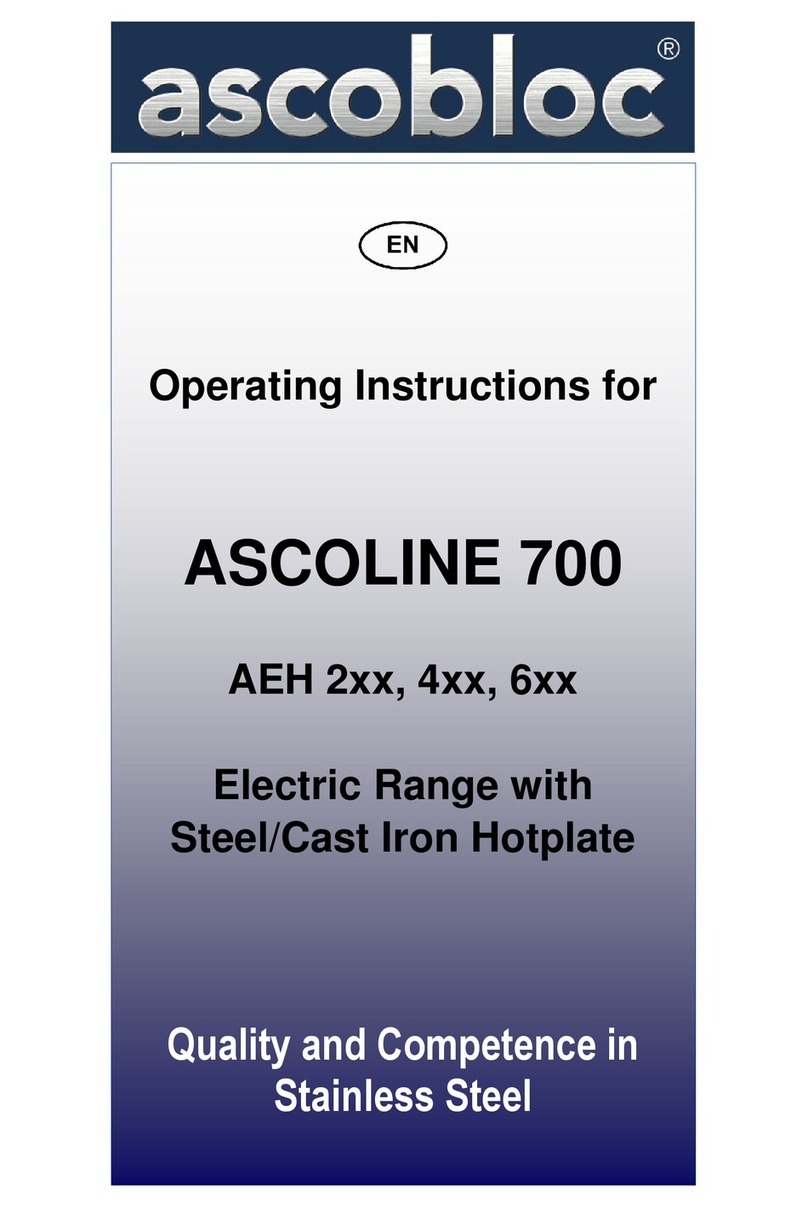
Operating Instructions for Ascoline 850, MEH 3xx, 5xx, 7xx
ascobloc Gastro-Gerätebau GmbH 01156 Dresden, Grüner Weg 29 Germany
Tel.:
+49
351
4533-0
Fax:
+49
351
4537-339
E-mail:
[email protected] mehc3xff,
last
update:
31/03/2010
Subject to change without notice!
3
•In the case of appliances with pot detection, do not place any metal objects onto the glass ceramic
surface.
•Several parts such as the oven door or the top plate of the range are, by their nature, very hot due to
the high temperatures needed for cooking. Protect yourself by only touching the control elements
provided and by wearing clothing that prevents direct skin contact.
•The system may only be operated and cleaned by personnel who have received appropriate
instructions. Maintenance and repair may only be performed by qualified specialists who have received
training.
•The manufacturer cannot be made liable for damage due to inexpert connection and handling. Claims
under the guarantee in such cases are null and void.
•Before repair work is started, the equipment must be disconnected on all poles from the power (using
isolating equipment in the customer's supply, e.g. contact breakers).
3.3 Instructions for transport
•Transport ascobloc equipment only in the original packaging. This avoids unnecessary damage and
expense.
•Check equipment for damage.
•Do not lift or shift the appliance by holding the top plate, the bottom edges at the sides of the appliance
or by the door handles. The bottom edges at the front and rear of the appliance are provided for this.
3.4 Instructions on installation
•The appliance is wired up in the factory as far as the connector. All connection work must be carried
out by an authorised specialist company. Allow the technical experts to look at these documents. The
legally acknowledged regulations (Germany VDE, Austria ÖVE, Switzerland SEV etc.) and the
connection requirements of the local electricity utility are to be observed.
•Before beginning the installation work, it should be checked that the mains voltage, mains type and the
current rating of the circuit breaker match the values given on the type plates. An isolating device in the
customer's scope of supply that is effective on all poles must be provided, e.g. contact breakers with at
least 3 mm contact gaps, so that the equipment is disconnected from the power supply during repair
and installation work. Connection to an equipotential bonding system is available. Make the
connections in accordance with the local regulations.
•Mains cables are not to be sharply bent, crushed or damaged by sharp edges. Mains cabling is to be
so laid that contact with hot parts cannot occur. The power supply cable must be led through the
equipment, fully sheathed, from the screwed connection to the entry of the terminal box. The appliance
is intended for a permanent connection; connection via plug and socket is not permitted.
4 Installation
4.1 Setting up
Do not set up the equipment next to walls, kitchen furniture, and decorations or similar which are made of
flammable materials. Otherwise there is danger of fire. See connection diagram with equipment
description for minimum distance. Local fire protection regulations must be kept to absolutely!
It is of importance that the equipment be set up absolutely horizontal (use spirit level for alignment) so
that the doors can be opened and closed without any problem and that they seal tightly when closed.
Equipment with adjustable feet can easily compensate for unevenness in the floor (+/- 20 mm) by turning
the bottom ends of the feet. If set up on a plinth, this is to have shims fitted underneath to compensate for
unevenness, if required.
4.1.1 Free-standing set-up
If the equipment is to be set up on its own, suitable means are to be used to protect it against tilting and
shifting.
4.1.2 Setting them up in groups or blocks
When setting up in groups or blocks, the equipment must be joined together by connecting elements
provided for this purpose. This is for the sake of hygiene. Observe equipment setting up sheets or
assembly diagram (data sheet in annex).
4.2 Connections
Details of connections for the media can be taken from the accompanying connection diagram and
equipment description. Check whether the size and position of the electrical connections of the customer
side correspond to the information in the connection plan, equipment description or installation plan.
































